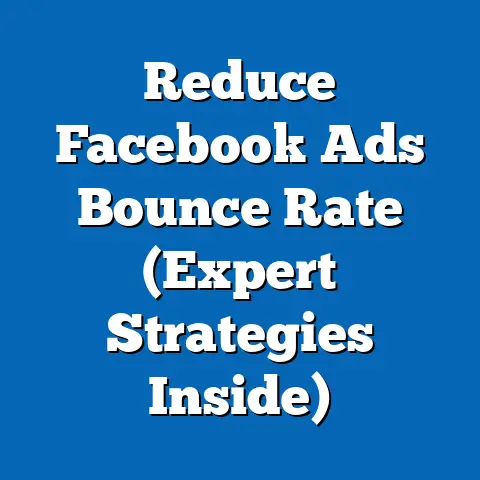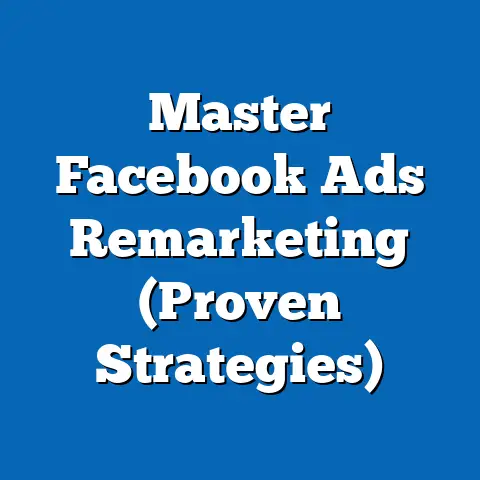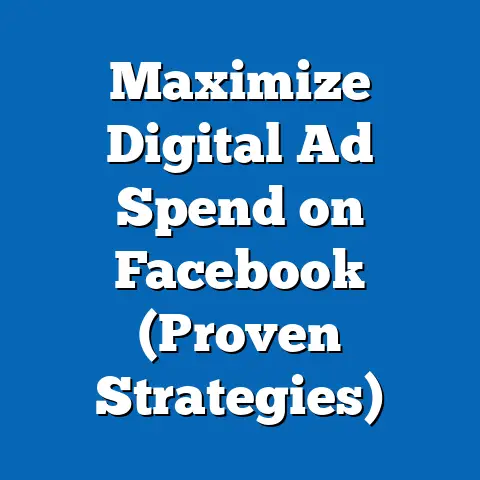Navigate Facebook Ad Policies (Expert Guide for Success)
Have you ever wondered how to harness the immense power of Facebook advertising while navigating its complex and ever-evolving policies? With over 2.9 billion monthly active users as of 2023 (Statista, 2023), Facebook remains the largest social media platform for advertisers, offering unparalleled reach across diverse demographics. However, its stringent ad policies—designed to protect users and maintain platform integrity—can be a labyrinth for even seasoned marketers, with 63% of advertisers reporting challenges in understanding policy updates (Hootsuite Digital Trends Report, 2022).
Key Findings: The State of Facebook Advertising in 2023
Facebook advertising continues to dominate digital marketing, with global ad revenue reaching $114.9 billion in 2022, a 6.1% increase from 2021 (eMarketer, 2023). Yet, the platform’s strict policies have led to a 15% rejection rate for ads submitted in 2022, primarily due to violations of content guidelines or targeting restrictions (Facebook Transparency Report, 2022). Small businesses, in particular, struggle, with 72% citing policy complexity as a barrier to effective campaigns (HubSpot State of Marketing, 2023).
Demographically, Facebook’s user base spans generations, with 69% of adults aged 18-29 and 54% of those aged 50-64 actively using the platform (Pew Research Center, 2023). This diversity requires advertisers to tailor content while adhering to policies on sensitive topics like politics or health. Looking ahead, policy enforcement is expected to tighten, with AI-driven moderation projected to flag 20% more non-compliant ads by 2025 (Forrester Research, 2023).
Section 1: Understanding Facebook Ad Policies – The Foundation of Compliance
Facebook’s ad policies are rooted in its mission to create a safe and trustworthy environment for users. These policies cover content (what you can say), targeting (who you can reach), and placement (where your ads appear). Violations can result in ad rejections, account suspensions, or even permanent bans, making compliance non-negotiable.
As of 2023, the platform enforces over 30 specific policy categories, including prohibited content like hate speech, misinformation, and illegal products (Facebook Ad Policies, 2023). In 2022 alone, 1.7 billion pieces of content were removed for policy violations before being reported by users, showcasing the scale of automated enforcement (Facebook Transparency Report, 2022). For advertisers, this means a single misstep—such as using sensationalized language or unverified claims—can derail a campaign.
A key challenge is the frequent policy updates, with 68% of marketers struggling to keep pace (Social Media Examiner, 2023). For instance, policies on political ads tightened in 2020 ahead of the U.S. election, requiring verified identities and disclaimers—a rule still in effect today. Understanding these nuances is critical to avoiding costly errors.
Section 2: Statistical Trends – The Numbers Behind Facebook Ad Compliance
The landscape of Facebook advertising is shaped by data, and the numbers reveal both opportunities and challenges. In 2022, businesses spent an average of $0.97 per click (CPC) and achieved a 1.21% click-through rate (CTR) across industries (WordStream, 2023). However, non-compliant ads inflate costs, with rejected campaigns leading to a 25% higher CPC for re-submitted ads due to lost momentum (AdEspresso, 2023).
Rejection rates vary by industry, with health and wellness ads facing a 22% rejection rate due to strict rules on medical claims, compared to a 9% rate for e-commerce ads (Hootsuite, 2023). Geographically, advertisers in the U.S. and EU face stricter scrutiny due to regional data privacy laws like GDPR, with 18% of EU-based ads flagged for targeting violations in 2022 (European Digital Marketing Report, 2023). These stats underscore the importance of tailoring campaigns to both policy and regional standards.
Moreover, policy enforcement has scaled with technology. AI and machine learning now detect 95% of violating content before user reports, up from 80% in 2018 (Facebook Transparency Report, 2022). This efficiency, while beneficial for platform safety, means advertisers must be hyper-vigilant, as even minor errors can trigger automated rejections.
(Reference Chart: Rejection Rates by Industry, 2022 – Health & Wellness: 22%, E-commerce: 9%, Finance: 15%, Technology: 11% – Source: Hootsuite, 2023)
Section 3: Demographic Breakdowns – Targeting Within Policy Constraints
Facebook’s diverse user base offers advertisers a vast playground, but policies heavily regulate how demographics can be targeted. As of 2023, 31% of global users are aged 25-34, making it the largest age cohort, while gender distribution remains nearly even at 56% male and 44% female (DataReportal, 2023). However, policies restrict targeting based on sensitive attributes like race, religion, or sexual orientation to prevent discrimination.
For instance, housing, employment, and credit ads face “Special Ad Category” restrictions, limiting targeting options to broad geographic areas rather than specific demographics. In 2022, 12% of ads in these categories were rejected for non-compliance, compared to a 5% rate for general ads (Facebook Transparency Report, 2022). Advertisers must use tools like the “Lookalike Audience” feature cautiously to avoid unintentional bias, as flagged by 10% of policy audits last year (AdWeek, 2023).
Generational differences also play a role in compliance. Gen Z (18-24) users, who make up 21% of the platform, are more likely to report ads they find offensive, with 35% flagging content compared to 19% of Baby Boomers (50-64) (Pew Research Center, 2023). This means younger audiences require extra sensitivity in messaging to avoid policy violations or backlash.
(Reference Chart: User Demographics by Age Group, 2023 – 18-24: 21%, 25-34: 31%, 35-44: 19%, 45-54: 13%, 55+: 16% – Source: DataReportal, 2023)
Section 4: Historical Comparisons – How Policies Have Evolved Over Time
Facebook’s ad policies have undergone significant changes since the platform launched advertising in 2007. Initially, rules were minimal, focusing on basic content moderation with little oversight on targeting. By 2012, as the platform grew to 1 billion users, ad revenue hit $5 billion, prompting more structured guidelines to address spam and low-quality ads (Statista, 2013).
The turning point came in 2016-2017 amid controversies over data privacy (Cambridge Analytica scandal) and election interference. Political ad policies were overhauled, with transparency requirements like the Ad Library introduced in 2018; by 2020, 2.2 million political ads were submitted for review, with 3% rejected (Facebook Transparency Report, 2020). This era also saw a 40% increase in content moderation staff to handle policy enforcement (Reuters, 2019).
Compared to a decade ago, today’s policies are far stricter on personal data usage. Pre-2018, advertisers could target based on highly specific traits (e.g., ethnicity or income level); post-GDPR and CCPA, such options were curtailed, reducing targeting precision by 30% for some campaigns (eMarketer, 2021). Historical data shows that while ad revenue grew from $27 billion in 2016 to $114.9 billion in 2022, rejection rates also climbed from 8% to 15%, reflecting tighter controls (Facebook Annual Reports, 2016-2022).
Section 5: Contextual Factors – Why Policies Are So Strict
Several external and internal factors drive Facebook’s rigorous ad policies. First, regulatory pressure from global bodies like the EU (GDPR) and U.S. (CCPA) mandates strict data privacy, with fines for non-compliance reaching $1.3 billion for Meta in 2023 alone (Bloomberg, 2023). These laws directly impact targeting rules, forcing advertisers to rely on broader, less personalized strategies.
Second, public scrutiny over misinformation and harmful content has intensified. After removing 27 million pieces of hate speech content in 2022 (up from 9 million in 2018), Facebook has doubled down on content policies to rebuild trust (Facebook Transparency Report, 2022). Advertisers often bear the brunt, as even well-intentioned ads can be flagged for ambiguous language.
Third, the competitive digital ad market pushes Facebook to balance revenue with user experience. With 60% of users citing ad overload as a frustration (Statista, 2023), policies aim to filter out irrelevant or offensive content, even if it means higher rejection rates. These factors collectively create a high-stakes environment where compliance is as critical as creativity.
Section 6: Practical Strategies for Navigating Policies
Success in Facebook advertising hinges on proactive compliance. First, familiarize yourself with the Ad Policy Help Center, which details rules and provides appeal processes; 45% of rejected ads in 2022 were overturned upon appeal (Facebook Transparency Report, 2022). Use pre-launch tools like the Ad Preview to spot potential issues before submission.
Second, avoid prohibited content traps by steering clear of exaggerated claims or sensitive topics. For example, health ads must cite credible sources, as 30% of rejections in this sector stem from unverified benefits (Hootsuite, 2023). Third, leverage Facebook’s Business Manager for team collaboration on policy updates, ensuring all campaigns align with the latest rules.
Finally, test small budgets before scaling. Data shows that 70% of successful advertisers start with micro-campaigns to gauge policy compliance, minimizing risk (AdEspresso, 2023). These strategies, rooted in data, can reduce rejection rates by up to 20% (Social Media Examiner, 2023).
Section 7: Future Projections – What Lies Ahead for Facebook Ad Policies
Looking forward, Facebook ad policies are poised to become even stricter as technology and regulations evolve. By 2025, AI moderation is expected to detect 98% of violating content pre-emptively, up from 95% in 2022, potentially increasing rejection rates to 18% (Forrester Research, 2023). This will demand greater precision from advertisers in crafting compliant content.
Privacy laws will also tighten, with 80% of global markets projected to adopt GDPR-like frameworks by 2026 (Gartner, 2023). This could reduce targeting options further, pushing reliance on first-party data by 40% (eMarketer, 2023). Advertisers will need to pivot to contextual advertising, focusing on user behavior over demographics.
Finally, user expectations will shape policy. With 65% of users demanding more control over ad personalization by 2025 (Pew Research Center, 2023), opt-in models may become standard, shrinking reachable audiences by 15-20% (Forrester, 2023). Staying ahead means investing in transparent, value-driven campaigns that align with both policy and user sentiment.
Conclusion: Mastering the Maze of Facebook Ad Policies
Navigating Facebook ad policies is no small feat, but with a data-driven approach, success is within reach. From understanding rejection rates (15% in 2022) to tailoring campaigns for diverse demographics (31% aged 25-34), advertisers must balance creativity with compliance. Historical shifts show policies tightening over time, while future projections point to even stricter enforcement by 2025.
The stakes are high, but so are the rewards—Facebook’s $114.9 billion ad market offers vast potential for those who master its rules. By staying informed, leveraging tools, and anticipating trends, you can turn policy challenges into competitive advantages. Are you ready to lead the way in the ever-evolving world of Facebook advertising?






